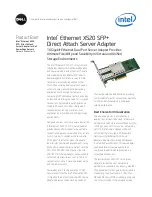
2
Intel’s I/O technology, Virtual Machine Device queues
1
(VMDq)
optimizes network performance by offloading data sorting and
copying from the software Virtual Switch in the VMM to the Intel
Ethernet 82599 10 Gigabit Controller. This configuration is best
suited for a large number of VMs running standard applications
that have limited bandwidth and latency requirements.
For mission-critical applications, where dedicated I/O is required
for maximum network performance, users can assign a dedicated
virtual adapter port to a VM. The Intel Ethernet X520 Server
Adapter provides direct VM connectivity and data protection
across VMs using SR-IOV.
2
SR-IOV technology allows the data
to bypass the software virtual switch and provides near-native
performance. It assigns either physical or virtual I/O ports
to individual VMs directly. This technology is best suited for
applications that demand the highest I/O throughput and lowest
latency performance such as database, storage, financial and
other applications.
The PCI-SIG SR-IOV capability is a mechanism for devices
to advertise their ability to be directly assigned to multiple
virtual machines. This technology allows for the partitioning
of a PCI function into many virtual interfaces for the purpose
of sharing the resources of a PCI Express* (PCIe) device in a
virtual environment. These virtual interfaces are called Virtual
Functions. Each virtual function can support a unique and
separate data path for I/O-related functions within the PCI
Express hierarchy. Use of SR-IOV with a networking device, for
example, allows the bandwidth of a single port (function) to be
partitioned into smaller slices that may be allocated to specific
VMs, or guests, via a standard interface.
The Intel Ethernet X520 Server Adapter delivers the same
functionality and throughput as ten dual-port one-Gigabit
adapters, saving cost, power, and complexity. For more
information on virtualization please go to
www.intel.com/go/vtc.
Unified Networking and Storage
The family of Intel Ethernet X520 server adapters lowers your
data center total cost of ownership (TCO) by providing the ability
to route LAN and SAN traffic over a single fabric.
Support for Fiber Channel over Ethernet (FCoE)
2
FCoE encapsulates Fiber Channel frames over standard Ethernet
networks, enabling Fiber Channel to take advantage of 10
GbE networks while preserving its native protocol. The X520
server adapter offers FCoE hardware acceleration to provide
performance comparable to FC HBAs. The new server adapters
support Data Center Bridging, also known as Converged
Enhanced Ethernet (CEE), which allows customers to configure
traffic classes and priorities to deliver a lossless Ethernet
fabric. An Intel Ethernet X520 Server Adapter reduces TCO by
eliminating redundant fabrics and saves the cost of expensive FC
HBAs and FC switch ports.
Support for iSCSI
The server adapters provide complete support for proven native
OS and VMM iSCSI initiators as well as iSCSI boot. Historically,
CRC32C computation has degraded system performance, but
now with the CRC instruction set included in the latest Intel®
Xeon® processors, CRC validation is possible with minimal impact
to network throughput while delivering superior data integrity.
The new Intel Ethernet X520 SFP+ DA Server Adapter for Dell
PowerEdge servers does it all: 10 Gigabit LAN, FCoE, and iSCSI;
truly delivering on the promise of unified networking.
Reliable Performance
The X520 server adapter includes a number of advanced
features that allow it to provide industry-leading performance
and reliability.
Security Optimizations
The adapter supports IPsec offload for Microsoft’s Network
Access Protection (NAP), Active Directory,* and future security
capabilities in Windows* 7. An X520 server adapter allows
customers to run a secure network environment without
sacrificing performance.
PCIe v2.0 (5 GT/s)
PCIe v2.0 (5 GT/s) support enables customers to take full
advantage of 10 GbE by providing a maximum of 20 Gbps
bi-directional throughput per port on a single dual port card.
Designed For Multi-core Processors
Support for technologies such as Intel® QuickData, multiple MSI-X
vectors, and Low Latency Interrupts allow the X520 server
adapter to provide high-performance, 10 Gigabit connectivity
in multi-core PowerEdge servers. These technologies distribute
network processing across multiple CPU cores, improving overall
performance.
For today’s demanding virtualized data center environments,
the new X520 server adapter delivers ultimate flexibility and
scalability.























